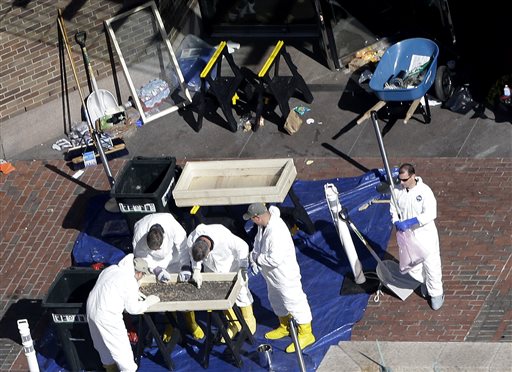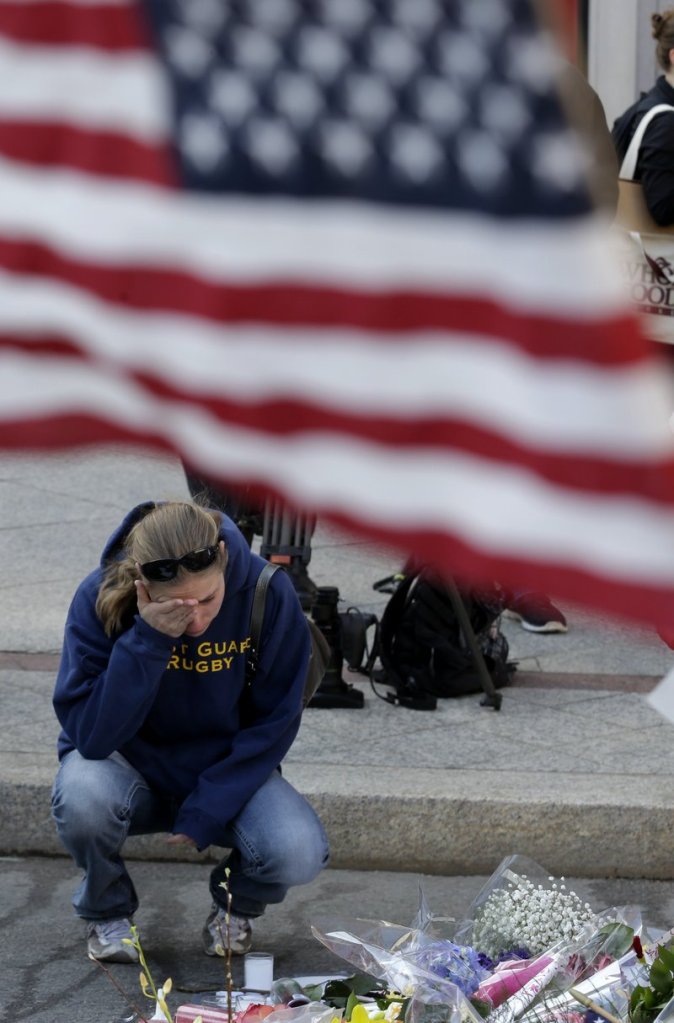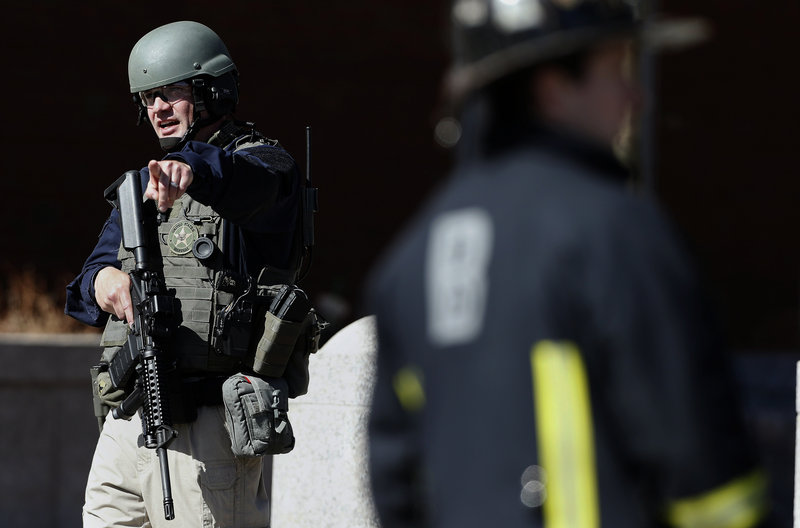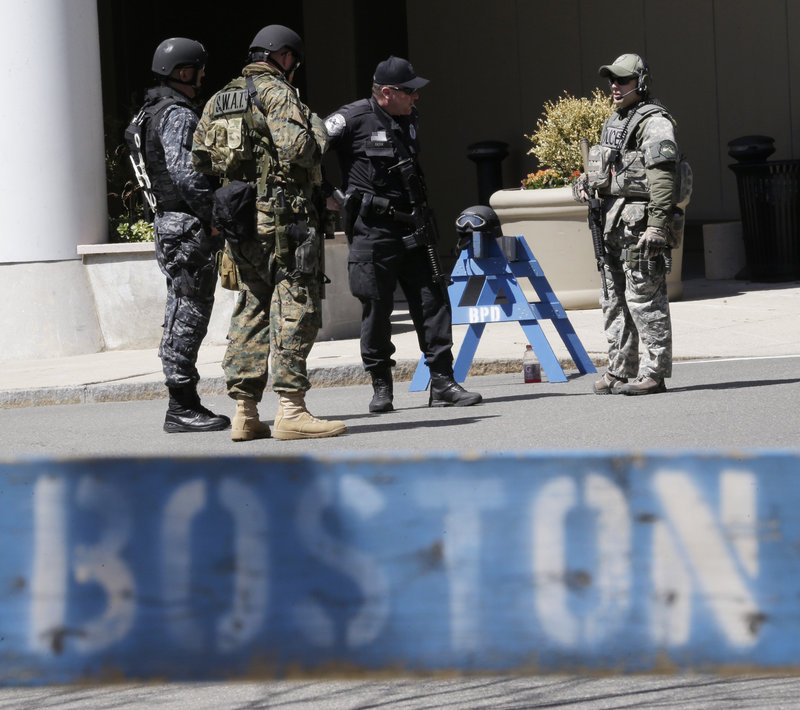BOSTON —The daunting task of sifting through thousands of images of the Boston Marathon bombing site in search of a culprit suddenly telescoped to a single video from a Lord & Taylor security camera Wednesday.
The discovery of video of a man who wore a large backpack to the finish line area and then dropped the package there raised hopes for an imminent breakthrough in the case, setting off a media frenzy and insistent statements from authorities that no arrest has been made.
A Boston city official said the video is of “special interest” to investigators.
The second full day of the investigation into the attack that killed three people and injured at least 176 brought jitters, rumors and at least the hope that investigators had made important progress, although Massachusetts Gov. Deval Patrick said that while the probe is “making some progress . . . it’s going to be slow, it’s going to be methodical.”
Boston’s federal courthouse, where hundreds had gathered in response to false reports of an arrest, was briefly evacuated because of a bomb threat. Officials also evacuated a Boston hospital, Brigham and Women’s, and Oklahoma City City Hall because of suspicious vehicles outside. No explosives were found in those cases.
In Boston, at least 14 bombing victims, including three children, remained in critical condition. Dozens of victims have been released from hospitals, and officials at three hospitals that treated some of the most seriously injured said they expected all their remaining patients to survive.
A 2-year-old boy with a head injury was improving and might go home Thursday, Boston Children’s Hospital said.
And Boston University released the name of a previously unidentified woman who was killed in the blast. Lu Lingzi, a graduate student in math and statistics at the university and a Chinese national, was watching the race with friends when the bombs went off.
The White House announced that President Barack Obama will be joined by his wife, Michelle, at an interfaith memorial ceremony in Boston on Thursday.
“The way that the people of Boston and the city of Boston responded reminds us – and reminds the world – of just who we are as a people,” spokesman Jay Carney said.
Wednesday’s whirlpool of reports demonstrated the extraordinary promise and power that new technologies bring to criminal investigations, but also the risk and unreasonable expectations that now permeate such probes. When federal authorities asked the public for help Monday, they received thousands of video clips and still images of the bomb site.
Some people, empowered by smartphones and ever more sophisticated technology, didn’t leave the detective work to the professionals. They joined forces on sites such as Reddit.com to examine crowd pictures, searching for – and then virally distributing – image of backpacks that resembled the shredded bag in photos the FBI released Tuesday.
Black backpacks turn out to be ubiquitous, and when five of them were found in a single photo of the crowd on Boylston Street, the search quickly drew criticism from readers worried that innocent people could be harmed by being identified as suspicious.
Others questioned whether black backpacks were even the most important lead, recalling the search for white box trucks that steered investigators astray in the Washington sniper case a decade ago.
At midday, news organizations such as CNN and the Associated Press reported that investigators had identified a suspect or made an arrest, leading the FBI to issue an unusual appeal: “Contrary to widespread reporting, there have been no arrests made in connection with the Boston Marathon attack. . . . Since these stories often have unintended consequences, we ask the media, particularly at this early stage of the investigation, to exercise caution and attempt to verify information through appropriate official channels before reporting.”
CNN said it “had three credible sources on both local and federal levels” for its reports. “As soon as our sources came to us with new information, we adjusted our reporting.”
In Boston, police barricades still ringed a 12-block area around the finish line, guarded by city police and the Massachusetts National Guard.
Doug Silkwood, a runner wearing his official marathon jacket, stopped at the barricade and recalled how he’d expected his first Boston Marathon to end with “hundreds of thousands of people having a great time.”
The bombings dashed all that, said Silkwood, 47, an engineer from San Jose, Calif.: “It’s probably easier to protect a Boston Celtics game than an open event like the marathon,” but he said he plans to return next year, “to do it out of spite.”
At Boston Medical Center, Jenny Chung, a 35-year-old teacher, was released at midday, less than 48 hours after shrapnel was blown into her chest, two inches from her heart.
She wore an honorary marathon finisher’s medal and carried a teddy bear that relatives had sent her. The medal was a gift from a marathon volunteer; Chung did not run the race, but was a spectator, there to watch a friend whose run ended prematurely.
Chung had been poised to record her friend’s triumphant finish when she was knocked to the ground. She felt little pain as she and her friends hurried away.
Only when she got to a friend’s apartment did she see blood oozing from her chest. She went to the hospital, where doctors quickly operated to remove the fragment. Investigators collected all her clothing, including her sneakers, for possible clues, she said.
At the finish line, Chung had stood with her runner friend’s boyfriend, who held a half dozen yellow helium balloons. Shrapnel from the blast cut open the boyfriend’s calf, and popped some of the balloons. The rest slipped from his grasp as he fell.
In video of the scene, a few yellow balloons drift upward, above the carnage.
Send questions/comments to the editors.





